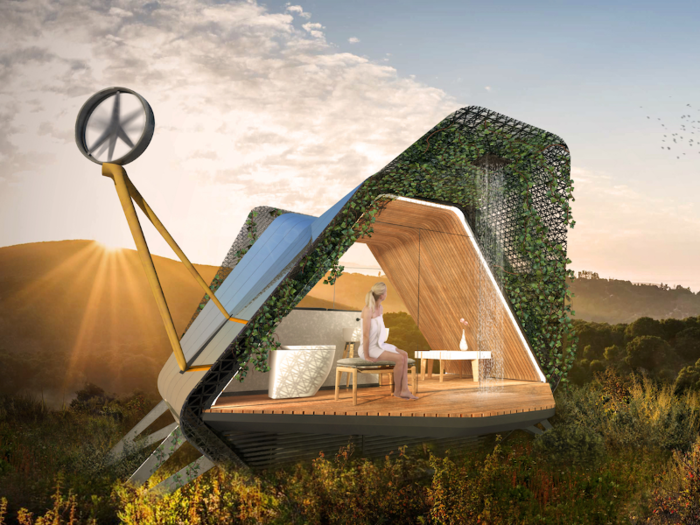
It's 300 square feet in size and takes around four to six weeks to construct.
The skin of the pod is developed by 3D-printing company Branch Technology, which is also currently developing construction methods for NASA's Mars ventures. It's a strong shell, consisting of carbon fiber, and sits atop a recycled aluminum base holding the pod off the ground.
The pods are made off-site and can be lugged from lot to lot on the property so that potential buyers can experience what it would be like to live there.
Source: Business Insider

The Galini is no different: It's 97% material efficient, meaning that only 3% of the materials that go into each unit are wasted. Everything else, the wood paneling inside, the recycled plastic used in construction, the LED lighting, the plumbing and mechanical systems, are "green" and efficient. As a result, the pod has no impact on the local environment.
A compression system works to draw water in from the atmosphere to provide the pod's occupants with a water supply. Solar panels and wind turbines power the unit, as does a lightweight battery sourced from Tesla, tech billionaire Elon Musk's energy company.
"[The pod] has a little belly under the floor," said Sayigh. That's where the Tesla battery rests.
Though ideally people would use fresh air to ventilate the pod by opening the doors, Sayigh said there is a system underneath the pod as well that can heat or cool the space if needed.
"If you've got Elon Musk coming to stay, you want to make sure the guy is comfortable," Sayigh said.

The unit's mobility means it can be put on the back of a truck and transported anywhere: to an agrihood community on California's Monterey coastline, or an obscure patch of land in the Nevada desert. It could potentially replace more environmentally unfriendly mobile homes as we know them.
"This is the sustainable airstream of our time," Sayigh said.
 I spent $2,000 for 7 nights in a 179-square-foot room on one of the world's largest cruise ships. Take a look inside my cabin.
I spent $2,000 for 7 nights in a 179-square-foot room on one of the world's largest cruise ships. Take a look inside my cabin. Saudi Arabia wants China to help fund its struggling $500 billion Neom megaproject. Investors may not be too excited.
Saudi Arabia wants China to help fund its struggling $500 billion Neom megaproject. Investors may not be too excited. One of the world's only 5-star airlines seems to be considering asking business-class passengers to bring their own cutlery
One of the world's only 5-star airlines seems to be considering asking business-class passengers to bring their own cutlery From terrace to table: 8 Edible plants you can grow in your home
From terrace to table: 8 Edible plants you can grow in your home
 India fourth largest military spender globally in 2023: SIPRI report
India fourth largest military spender globally in 2023: SIPRI report
 New study forecasts high chance of record-breaking heat and humidity in India in the coming months
New study forecasts high chance of record-breaking heat and humidity in India in the coming months

Copyright © 2024. Times Internet Limited. All rights reserved.For reprint rights. Times Syndication Service.